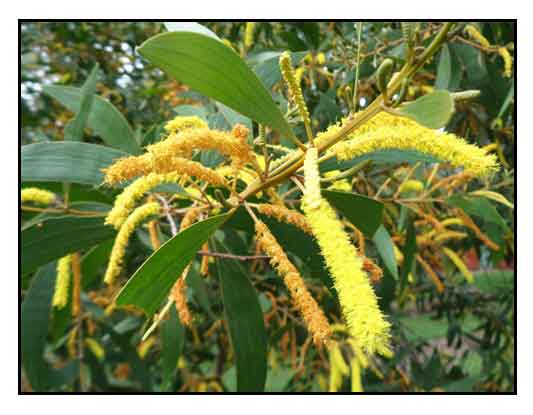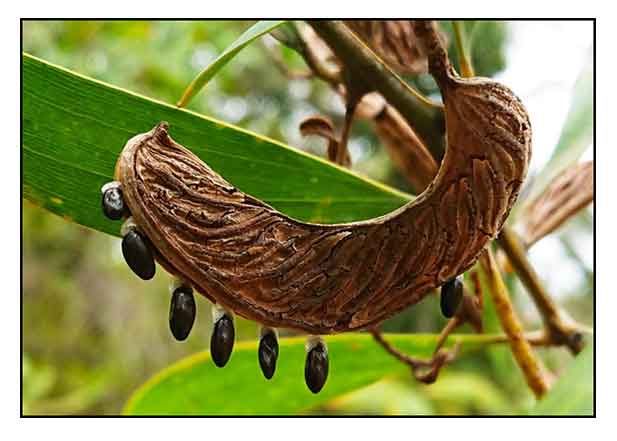 Botany Botany
Golden flower salwood is an evergreen shrub or tree varying widely in size, from a 3 meter tall shrub to a slender, large tree as high as 40 meters. The trunk in larger trees are free of branches up to 21 meters with the bole100 centimeters in diameter. Bark is generally smooth, but often cracked and fissured at the base of taller trees. Branchlets are glabrous, acute angled, slender to sub-stout. The mature plant does not have true leaves, but rather, leaf-like flattered stems called phyllodes. Phyllodes are dimidiate to subfalcate in shape, glaucous with a slight sheen. with numerous parallel longitudinal nerves. Inflorescences are simple, 1 to 2 per axil; peduncles 4 to 8 millimeters long, spikes 2 to 5 centimeters long, bright golden. Flowers are 5-merous; calyx gamosepalous, shallowly dissected, glabrous. Pods are narrowly oblong, twisted, straight or shallowly curved, 1.5 to 8 centimeters long, 0.8 to 1.5 centimeters wide, woody, resinous, glabrous reddish brown, dehiscing along the dorsal suture. Seeds are oblique ovate to oblong or elliptic, 3.5 to 5 millimeters long brown to black, with a grayish aril. (2) (4) (8)
 Distribution Distribution
- Introduced.
- Cultivated.
- Classified as Near Threatened" in the ICUN Red List
of Threatened Species, 2011.(5)
- Native to Australia, New Guinea, Irian Jaya.
Constituents
- Study of A. aulacocarpa for chemical constituents showed every size had high alpha-cellulose (average 65%) low lignin (18-20%), low ash (0.02 to 0.04%) and pentosan (average 15%). (see study below) (6)
Properties
- Bark considered astringent.
- Study has suggest antibacterial properties.
Uses
Folkloric
- No reported folkloric medicinal use in the Philippines.
Others
- Agroforestry: A useful shade tree. Popular species for reforestation of poor soils.
- Tannins: Inner bark yields tannins.
- Wood: Pale brow to gray-brown, attractively streaked with gray bands. Hard and moderately durable, used as construction timber, for furniture, cabinetry, flooring, tool handles, boxes, joinery and turnery.
- Fiber: An excellent source of fiber for pulping and paper-making. (2)
- Fuel: Excellent source of fuel with energy value of 21,600 kJ/kg. Its charcoal has an energy value of 37,000 kJ/kg. (2)
Studies
• Antimicrobial / Leaves: Study of methanolic extract of A. aulacocarpa leaves inhibited 6 of 14 bacterial tested (43%). It displayed no activity against fungi tested. The extract displayed low toxicity in the Artemia franciscana bioassay. Results validate Australian aboriginal usage of the plant as antiseptic agents. (3)
• Source of Pulp and Paper: Study evaluated the chemical constituents of A. aulacocarpa with age of 17 years with small-, medium- and large-sized culm. Results showed every size had high alpha-cellulose (average 65%) low lignin (18-20%), low ash (0.02 to 0.04%) and pentosan (average 15%). Results suggest A. aulacocarpa has potential use as raw material for pulp and paper production (5)
• Antibacterial / Leaves: Study evaluated 39 methanolic extracts from 25 Australian native plants for antibacterial activity against two Gram positive (Bacillus cereus, B subtilis) and two gram negative bacteria ( (Aeromonas hydrophiia, Pseudomonas fluorescens) using disc diffusion study. Acacia aulococarpa exhibited good antibacterial activity against A. hydrophilia (7.7 ± 0.6, P. fluorescens 10.6 ± 0.3, and B. cereus 9.0 ± 1.0. (7)
Availability
Wild-crafted.
|

![]()



 Botany
Botany Distribution
Distribution